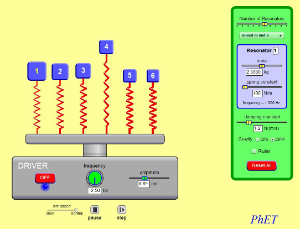Principal Sponsors
Makes grants to address the most serious social and environmental problems facing society, where risk capital, responsibly invested, may make a difference over time.
An independent federal agency created by Congress in 1950 to promote the progress of science.
King Saud University seeks to become a leader in educational and technological innovation, scientific discovery and creativity through fostering an atmosphere of intellectual inspiration and partnership for the prosperity of society.
The O'Donnell Foundation is devoted to building model programs to enhance the quality of education.
Resonance
 Download
Run Now!
621 kB
Version: 1.01 (change log)
Download
Run Now!
621 kB
Version: 1.01 (change log)
Embed a running copy of this simulation Use this HTML to embed a running copy of this simulation. You can change the width and height of the embedded simulation by changing the "width" and "height" attributes in the HTML. Embed an image that will launch the simulation when clicked Use this HTML code to display a screenshot with the words "Click to Run". |
For advanced undergraduate students: Observe resonance in a collection of driven, damped harmonic oscillators. Vary the driving frequency and amplitude, the damping constant, and the mass and spring constant of each resonator. Notice the long-lived transients when damping is small, and observe the phase change for resonators above and below resonance. |
Teaching Resources
Main Topics
- Resonance
- Harmonic Motion
- Oscillator
Keywords
Sample Learning Goals
- Explain the conditions required for resonance.
- Identify/explain the variables that affect the natural frequency of a mass-spring system.
- Explain the distinction between the driving frequency and natural frequency of a resonator.
- Explain the distinction between transient and steady-state behavior in a driven system.
- Identify which variables affect the duration of the transient behavior.
- Recognize the phase relationship between the driving frequency and the natural frequency, especially how the phase is different above and below resonance.
- Give examples the application of real-world systems to which the understanding of resonance should be applied and explain why.
Tips for Teachers
The teacher's guide (pdf) contains tips created by the PhET team.
Teaching Ideas
| Title | Authors | Level | Type | Updated |
|---|---|---|---|---|
|
Resonance: Upper-division college
|
Mike Dubson, Trish Loeblein | UG-Adv | CQs | 8/8/11 |
|
Resonance-Introduction to Natural Frequency
|
Trish Loeblein, Mike Dubson | UG-Intro HS |
HW CQs Lab |
7/5/13 |
|
Concept questions for Physics using PhET (Inquiry Based)
|
Trish Loeblein | HS UG-Intro |
CQs | 7/7/13 |
|
Wave unit (Inquiry Based)
|
Trish Loeblein | HS UG-Intro |
Demo Lab CQs |
7/9/13 |
|
Wave clicker questions (Inquiry Based)
|
Trish Loeblein | HS UG-Intro |
CQs | 7/9/13 |
| Moteur en PhET | Bernard Lacour | Other | Lab | 7/5/13 |
| Waves and sound(in dutch golven en trillingen) | Corné de Boer | HS | Demo | 4/11/12 |
You can submit your own ideas and activities.
Related Simulations
Translated Versions:
Software Requirements
| Windows | Macintosh | Linux |
|---|---|---|
|
Microsoft Windows
XP/Vista/7 Macromedia Flash 9 or later |
OS 10.5 or later
Macromedia Flash 9 or later |
Macromedia Flash 9 or later |
Credits
| Design Team | Third-party Libraries | Thanks To |
|---|---|---|
|
© 2013 University of Colorado.
Some rights reserved.



